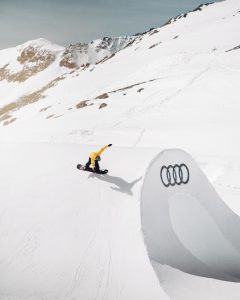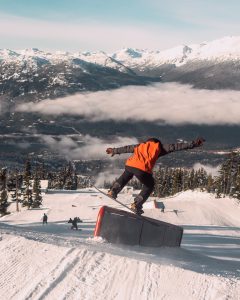 The 2022 winter Olympics are in full swing, and so is the insider language.
The 2022 winter Olympics are in full swing, and so is the insider language.
Normally I recommend using words people understand and explaining jargon, acronyms and unusual terms. Announcers during fast-paced Olympic sports don’t have time for that, or they assume viewers are familiar with the terms. Curling fans know all about buttons, draws and hammers, for instance. Those who adore ice skating wait for every triple Salchow, quad and twizzle.
The snowboarders are particularly fascinating. They don’t just have their own terms, it’s almost their own language. And because I’m the kind of person who looks up weird or unknown words, I had to dig in.
First, a number of recurring terms that are helpful to know:
- Goofy is riding with your right foot in front. Riding with your left foot in front is called regular.
- Switch is when the snowboarder rides in the opposite of their natural stance. Not to be confusing, this can also be called fakie. Riders are described as dropping in switch to the halfpipe (the U-shaped canyon carved in snow they ride in) or dropping in natural.
- Backside is the heel-side edge of the snowboard; frontside is the toe-side edge of the board.
- The four spin directions are called frontside, backside, switch frontside and switch backside, referring to stance and which way the trick starts. Switch backside is considered the hardest rotation type.
- What’s with all the numbers? Spins are measured in multiples of 180 degrees, with a full rotation being 360. Rail tricks are measured in multiples of 90 degrees.
Now here are some of the tricks I heard announcers call out, celebrate and lose their minds over:
- Air to fakie: The snowboarder flies up the half-pipe riding forward and lands backwards; a switch air to fakie can also be called a PopTart.
- Alley-oop: A trick where the snowboarder rotates in the uphill direction, opposite from what you’d expect. Add numbers for the degree of rotation, like Alley-oop 360.
- Blindside: Any rotation where the rider must stretch to look over their shoulder to see where they will take off or land.
- Bluntside: Landing on a rail – a terrain park feature meant to slide along; see next photo – with the tail of the board before sliding down.
- Butt check: Putting your rear down to stop a fall while still sliding along on the snowboard.
- Cab: A spin where the boarder turns 360 degrees and lands forward after starting backward. Add numbers for the rotations, like cab 720 or cab 1260.
- Chicken salad: Riders reach between their legs and grab the heel edge between the bindings with their back hand while straightening out their forward leg. Other grabs in this area are melon, roast beef and stalefish. (Why???)
- Cork: An off-axis spin where the snowboarder flips sideways or upside down. Two flips make a double cork, three a triple cork, and so on. Add numbers for the degree of rotation, like cork 720.
- Crippler: A 540-degree backflip done on the frontside wall.
- Fakie: Another term for switch riding (riding opposite the usual stance).
- Haakon flip: An inverted aerial where the rider approaches the frontside wall of the halfpipe while riding switch. At the lip of the halfpipe, the rider flips backwards and rotates 720 degrees, landing forward down in the pipe. Named after Norwegian snowboarder Terje Haakonsen.
- Japan grab: Riders grab the toe-side edge of the board in between their feet with the front hand and pull the front knee to the board.
- Landing switch: Landing backwards.
- McTwist: A front flip where the snowboarder turns one and a half times (540 degrees or more) while holding the edge of the board. Named after skateboarder Mike McGill.
- Melon grab: Riders reach their front hand behind the front legs and grab the heel edge between the bindings. (I heard one announcer ask, “Do you think the crippler is harder than the melon grab?” I didn’t hear the answer.)
- Mute grab: Riders use their front hand to grab the toe-side edge of the board between the bindings. Other grabs in this area are Taipan, mindy, Canadian bacon and indy.
- Ollie up the wall: A trick originating in skateboarding, where the rider and board leap into the air without the use of hands. Named after skateboarder Alan “Ollie” Gelfand.
- Popping hard: Extra spring given to an ollie by the flex of the board.
- Rodeo: An invert in which the rider rotates while flipping backward.
This results in a dizzying combination of moves. As NBC Olympics says, “The names of tricks will often include the spin direction, number of corks (if any), degree of rotation and type of grab.” Grabs add control in the air and style to the jump.
Thus a rider might land a switch backside triple cork 1440 mute grab. This means the rider approaches the jump in their unnatural stance (switch), starts the trick by spinning a backside rotation, at the same time doing three inverts (triple cork) and four full rotations (1440) in the air while holding a mute grab.
Got it? Me either.
There are many more terms, of course, and plenty of heart-stopping moves. So hats (or helmets) off to the snowboarders for their amazing talents. I might be able to briefly handle a butt check before wiping out!
First photo by Karl Köhler on Unsplash, taken in Austria in 2018.
Photo of riding the rails by Benjamin Hayward on Unsplash taken in Whistler, BC in 2022.
Related reading:
Snowboarding “grab” directory
Jargon and insider language? The 2016 Summer Olympics had ’em
“Curlingspeak” from the 2010 Vancouver Winter Olympics
Sports announcers get away with jargon, but don’t try this at home

